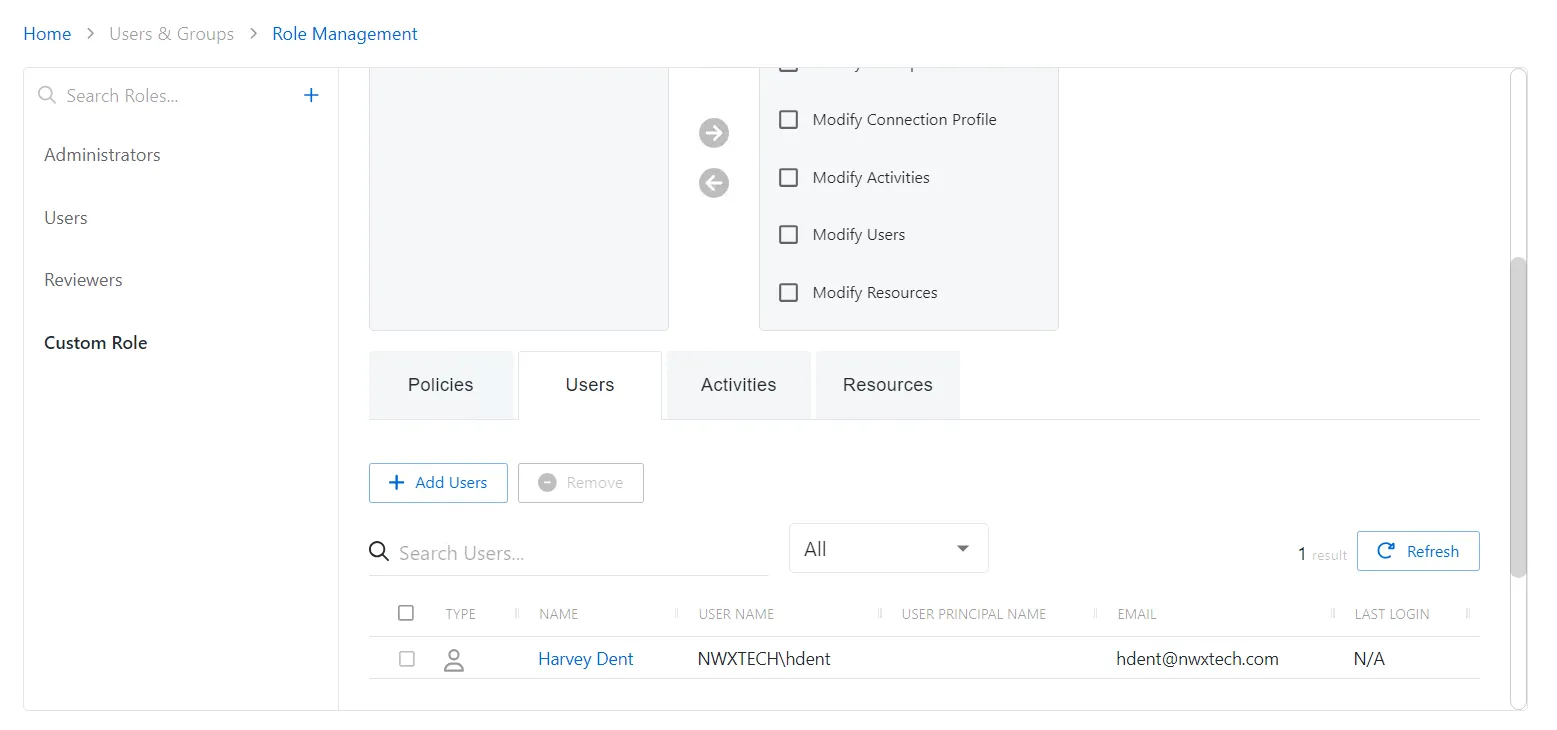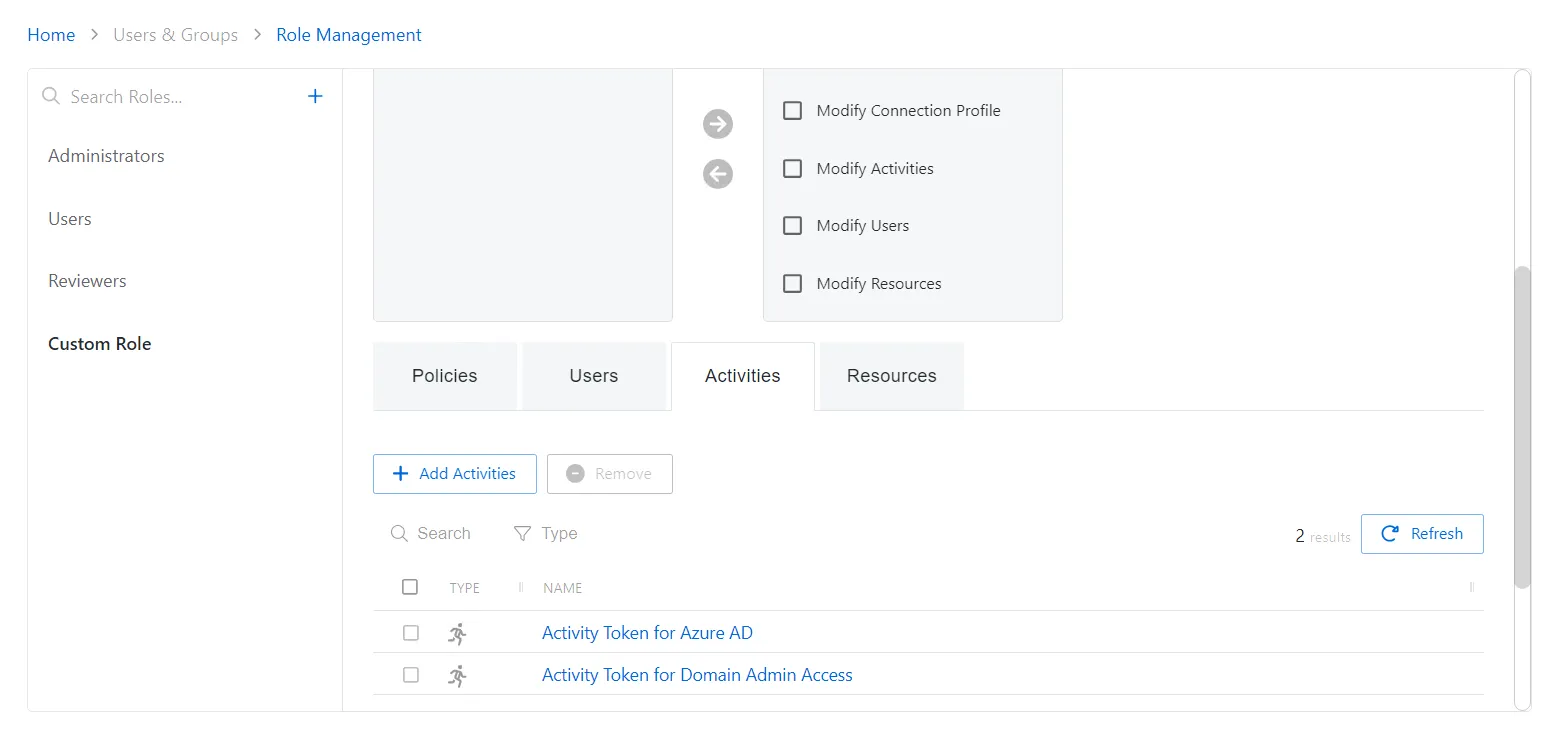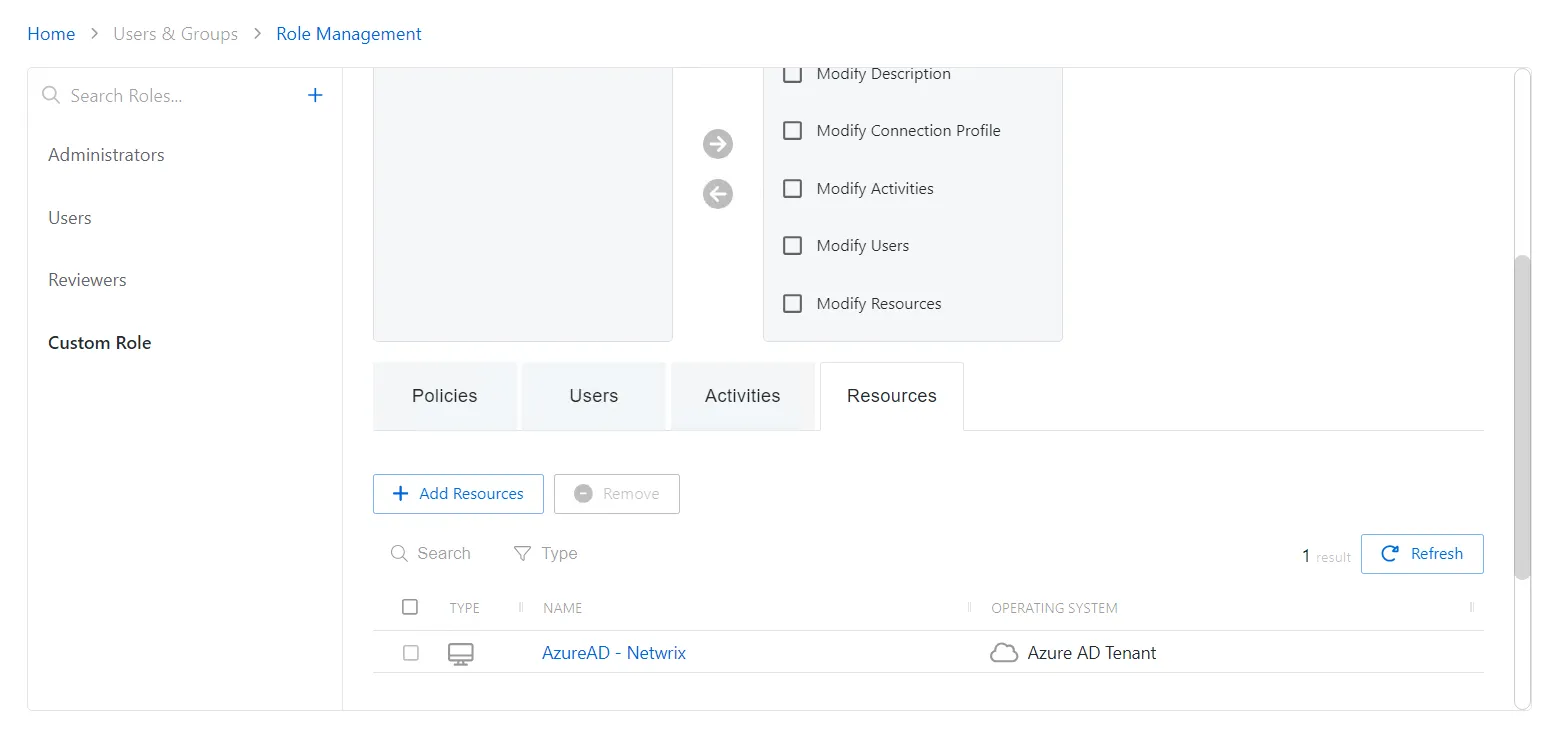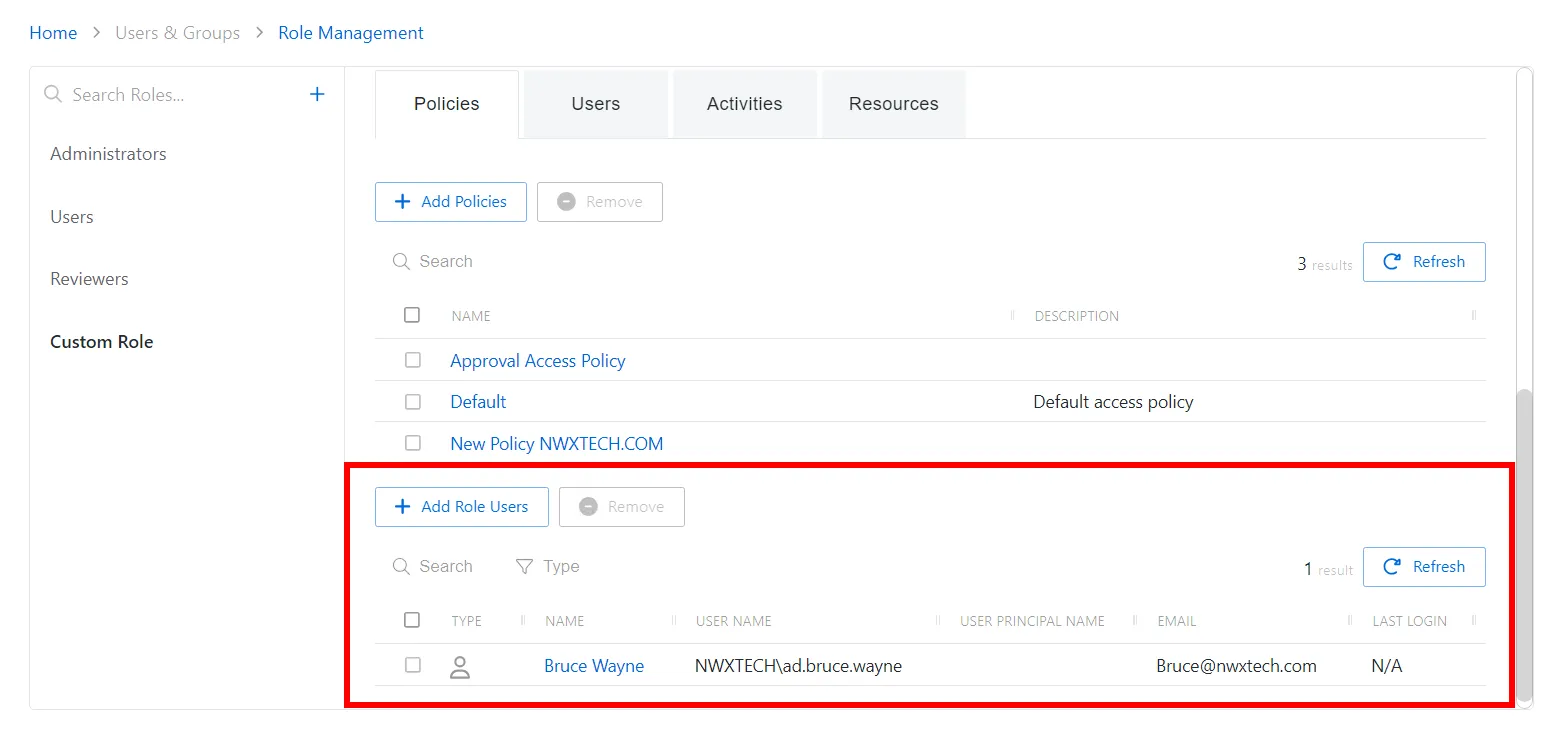Add Custom Role
The Add Role window allows users to add a role to Privilege Secure's Users & Groups Role Management module.
The Add Role window has the following features:
- Enter Role Name — Name that will be displayed to represent the role.
- Description — A brief summary of the purpose of the role.
- Save button — Saves the new role to the Users & Groups module.
- Cancel button — Cancels the Add Role process and closes the window.
Follow the steps below to add a role to the Users & Groups Role Management module.
Step 1 – Navigate to the Users & Groups > Role Management page.
Step 2 – Click the Add Role button.
Step 3 – Enter a Role Name.
Step 4 – (Optional) Add a description.
Step 5 – Click the Save button.
Once saved, the next step is to assign Permissions and users to this role. See the Custom Role Details Page topic for additional information.
Custom Role Details Page
The Role Management page is accessible from the Navigation pane under Users & Group. It provides details on all available roles for Privilege Secure users. There are default roles, and custom roles can be created.

When a custom role is selected, the selected role details display at the top of the main pane with the following features:
- Name — Name of the access policy
- Description — Description of the policy
- Permission Assignment section — Use this section to assign permissions for the custom role. See the Permission Assignment topic for additional information.
- Search — Searches the table or list for matches to the search string. When matches are found, the table or list is filtered to the matching results. This search is specific to the table in the Users section at the bottom.
- Filter — Provides options to filter results based on a chosen criterion: User, Group, Application, Collection, and Local User
- Add Role User — Opens Add Role Users window. See the Add Role Users Window topic for additional information.
- Remove — Removes console access from the selected account. This button is specific to the table in the Users role assignment section at the bottom.
- Refresh — Reload the information displayed. This button is specific to the table in the Users section at the bottom.
The Users role assignment section table has the following columns:
- Checkbox — Check to select one or more items
- Type — Icon indicates the type of object
- Name — Displays the name of the account. See the User, Group, & Application Details Page topic for additional information.
- User Name — Displays the sAMAccountName for the account
- User Principal Name — Displays the UPN value for the account
- Email — Displays the associated email address, if available
- Last Login — Date timestamp for the last time the user logged into the application
The table columns can be resized and sorted in ascending or descending order.
Permission Assignment
Each permission gives specific rights to users with the selected role. Permissions on the left are not associated with the role. Permissions on the right are assigned to the selected role.
Available permissions include:
- Modify Name — Grants permission to modify the names of Policies
- Modify Description — Grants permission to modify the descriptions of Policies
- Modify Connection Profile — Grants permission to modify connection profiles of Policies
- Modify Activities — Grants permission to modify activities. Selecting this option enables the Activities tab to scope the permission to specific Activities.
- Modify Users — Grants permission to modify associated users. Selecting this option enables the Users tab to scope the permission to specific Users.
- Modify Resources — Grants permission to modify associated resources. Selecting this option enables the Resources tab to scope the permission to specific Resources.
All custom roles, no matter what permissions are granted, can be scoped to specific policies. See the Change Permission Assignment topic for additional information.
Policy Tab
The Policy tab for a custom role has the following features:

- Search — Searches the table or list for matches to the search string. When matches are found, the table or list is filtered to the matching results. This search is specific to the table in the Policies tab.
- Add Policies — Opens the Add Policies window. See the Add Policies Window topic for additional information.
- Remove — Removes console access from the selected account.This button is specific to the table in the Policies tab.
- Refresh — Reload the information displayed. This button is specific to the table in the Policies tab.
The Policies tab table has the following columns:
- Checkbox — Check to select one or more items
- Name — Displays the name of the policy. Click the link to view additional details. See the Access Policy Page topic for additional information.
- Description — Description of the policy
Users Tab
The Users tab for a custom role has the following features:

- Search — Searches the table or list for matches to the search string. When matches are found, the table or list is filtered to the matching results. This search is specific to the table in the Users tab.
- Type — Provides options to filter results based on a chosen criterion: User, Group, Application, Collection, and Local User
- Add Users— Opens the Add Users and Groups window. See the Add Users & Groups Window topic for additional information.
- Remove — Removes console access from the selected account.This button is specific to the table in the Policies tab.
- Refresh — Reload the information displayed. This button is specific to the table in the Policies tab.
The Users tab table has the following columns:
- Checkbox — Check to select one or more items
- Type — Icon indicates the type of object
- Name — Displays the name of the account. See the User, Group, & Application Details Page topic for additional information.
- User Name — Displays the sAMAccountName for the account
- User Principal Name — Displays the UPN value for the account
- Email — Displays the associated email address, if available
- Last Login — Date timestamp for the last time the user logged into the application
Activities Tab
The Activities tab for a custom role has the following features:

- Search — Searches the table or list for matches to the search string. When matches are found, the table or list is filtered to the matching results. This search is specific to the table in the Activities tab.
- Type — Provides options to filter results based on a chosen criterion: Activity or Activity Group
- Add Activities — Opens the Add Activities and Activity Groups window. See the Add Activities and Groups Window topic for additional information.
- Remove — Removes console access from the selected account.This button is specific to the table in the Policies tab.
- Refresh — Reload the information displayed. This button is specific to the table in the Policies tab.
The Activities tab table has the following columns:
- Checkbox — Check to select one or more items
- Type — Classification of the activity
- Name — Displays the name of the activity. Click the link to view additional details. See the Activities Page topic for additional information.
Resources Tab
The Resources tab for a custom role has the following features:

- Search — Searches the table or list for matches to the search string. When matches are found, the table or list is filtered to the matching results. This search is specific to the table in the Resources tab.
- Type — Provides options to filter results based on a chosen criterion: Resource or Resource Group
- Add Resources — Opens the Add Resources and Groups window. See the Add Resources and Groups Window topic for additional information.
- Remove — Removes console access from the selected account.This button is specific to the table in the Policies tab.
- Refresh — Reload the information displayed. This button is specific to the table in the Policies tab.
The Resources tab table has the following columns:
- Checkbox — Check to select one or more items
- Type — Icon indicates the type of object
- Name — Displays the name of the resource. See the Resources Page topic for additional information.
- Operating System — Displays the operating system of the resource
Role Users
Role Users is located at the bottom of the Custom Role details page. This will be the user that has access to the Custom Role.

The Role Users has the following features:
- Search — Searches the table or list for matches to the search string. When matches are found, the table or list is filtered to the matching results. This search is specific to the table in the Users tab.
- Type — Provides options to filter results based on a chosen criterion: User, Group, Application, Collection, and Local User
- Add Role Users— Opens the Add Users and Groups window. See the Add Users & Groups Window topic for additional information.
- Remove — Removes console access from the selected account. This button is specific to the table in the Policies tab.
- Refresh — Reload the information displayed. This button is specific to the table in the Policies tab.
The Role Users table has the following columns:
- Checkbox — Check to select one or more items
- Type — Icon indicates the type of object
- Name — Displays the name of the account. See the User, Group, & Application Details Page topic for additional information.
- User Name — Displays the sAMAccountName for the account
- User Principal Name — Displays the UPN value for the account
- Email — Displays the associated email address, if available
- Last Login — Date timestamp for the last time the user logged into the application